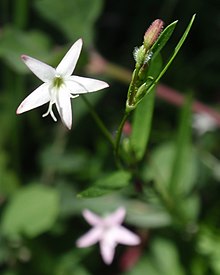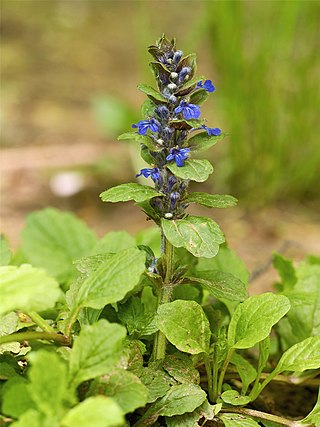
Ajuga, also known as bugleweed, ground pine, carpet bugle, or just bugle, is a genus of 40 species annual and perennial herbaceous flowering plants in the Ajugeae tribe of the mint family Lamiaceae, with most species native to Europe, Asia, and Africa, but also two species in southeastern Australia. They grow to 5–50 cm tall, with opposite leaves.

Arisaema is a large and diverse genus of the flowering plant family Araceae. The largest concentration of species is in China and Japan, with other species native to other parts of southern Asia as well as eastern and central Africa, Mexico and eastern North America. Asiatic species are often called cobra lilies, while western species are often called jack-in-the-pulpit; both names refer to the distinctive appearance of the flower, which consists of an erect central spadix rising from a spathe.

Osmanthus is a genus of about 30 species of flowering plants in the family Oleaceae. Most of the species are native to eastern Asia ,and was originally found in the middle east of the Himalayas, with a few species from the Caucasus, New Caledonia, and Sumatra. Osmanthus has been known in China since ancient times with the earliest writings coming from the Warring States period; the book Sea and Mountain. South Mountain states: "Zhaoyao Mountain had a lot of Osmanthus".
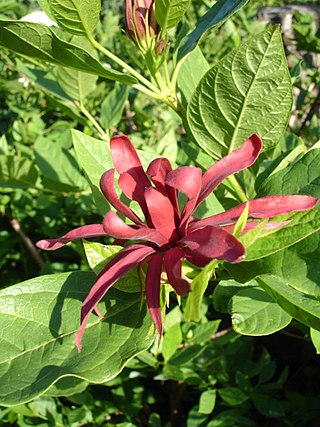
Calycanthus, called sweetshrub, is a genus of flowering plants in the family Calycanthaceae. The genus includes two to four species depending on taxonomic interpretation; three are accepted by most 21st century sources.

Maianthemum includes the former genus Smilacina and is a genus of perennial herbaceous flowering plants with fleshy, persistent rhizomes. It is widespread across much of North America, Europe and Asia, and may be terrestrial, aquatic or epiphytic. It is characterized by simple, unbranched stems that are upright, leaning or hanging down and have 2–17 foliage leaves. Leaves are simple and may clasp the stem or be short-petiolate. The inflorescence is terminal and either a panicle or a raceme with few to many pedicelate flowers. Most species have 6 tepals and 6 stamens; a few have parts in 4s. Tepals are distinct in most species and all of similar size. Flowers are spreading, cup-shaped or bell-shaped and usually white, but lavender to red or green in some species. Fruits are rounded to lobed berries containing few to several seeds.

Odontochilus is a small genus from the orchid family (Orchidaceae). These terrestrial, mycoparasitic orchids occur from China, Japan, the Himalayas, Southeast Asia, New Guinea and Melanesia. The genus is related to Gonatostylis, endemic to New Caledonia.

Rohdea is a genus of plants native to eastern Asia. It was long thought to contain only a single species, R. japonica, but recent studies have resulted in several other taxa being transferred into the genus.

Daphniphyllum is the sole genus in the flowering plant family Daphniphyllaceae and was described as a genus in 1826. The genus includes evergreen shrubs and trees mainly native to east and southeast Asia, but also found in the Indian Subcontinent and New Guinea.

Aletris, the colicroot, colicweed, crow corn, or unicorn root, is a genus of flowering plants in the family Nartheciaceae, native to North America and to eastern and southeastern Asia, especially China. It was used as a component in Lydia Pinkham's original Vegetable Compound.
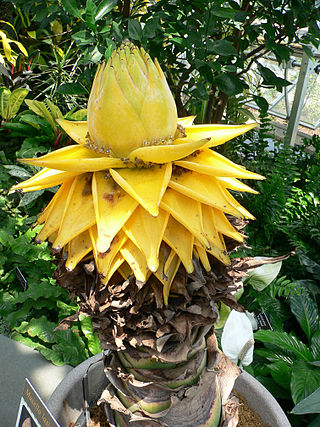
Musella lasiocarpa, commonly known as Chinese dwarf banana, golden lotus banana or Chinese yellow banana, is the sole species in the genus Musella. It is thus a close relative of bananas, and also a member of the family Musaceae.

Thermopsis is a genus of legumes, native to temperate North America and east Asia. They are herbaceous perennials and are known as goldenbanners or false-lupines.
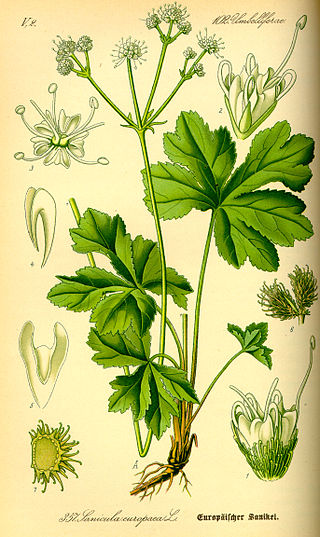
Sanicula is a genus of plants in family Apiaceae, the same family to which the carrot and parsnip belong. This genus has about 45 species worldwide, with at least 22 in North America. The common names usually include the terms sanicle or black snakeroot.

Linnaea is a plant genus in the honeysuckle family Caprifoliaceae. Until 2013, the genus included a single species, Linnaea borealis. In 2013, on the basis of molecular phylogenetic evidence, the genus was expanded to include species formerly placed in Abelia, Diabelia, Dipelta, Kolkwitzia and Vesalea. However, this is rejected by the majority of subsequent scientific literature and flora.
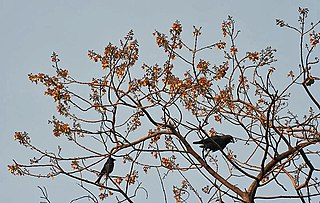
Gmelina is a genus of plants in the family Lamiaceae. It consists of about 35 species in Australia, New Guinea, New Caledonia, Southeast Asia, India and a few in Africa. Some species such as G. arborea have been planted and/or become naturalised in India, Africa and Australia. It was named by Carl Linnaeus in honour of botanist Johann Georg Gmelin.

Kobresia is a genus of plants in the sedge family. They are sometimes called bog sedges. These perennial sedges are quite similar to Carex species in appearance. The genus is widespread across much of Europe, Asia and North America, with many species native to the Himalayas.

Ypsilandra is a genus of at least six herbaceous plant species, first described as a genus in 1888. This genus is a member of the Melanthiaceae and is native to East Asia.

Tofieldia is a small genus of flowering plants described as a genus in 1778. It is widespread across much of Europe, Asia, and North America.

Funastrum is a genus of flowering plant now in the family Apocynaceae. The name is derived from the Latin word funis, meaning "rope", and astrum, alluding to the twining stems. Members of the genus are commonly known as twinevines.

Dregea is a genus of vines in the Apocynaceae, established by Ernst Meyer in 1838. It is native to southern Africa, Yemen and eastern Asia from China to Sulawesi.
